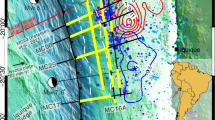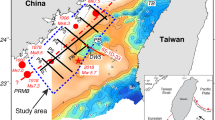Abstract
At the northern Cascadia margin, the Juan de Fuca plate is underthrusting North America at about 45 mm yr-1 (ref. 1), resulting in the potential for destructive great earthquakes2,3. The downdip extent of coupling between the two plates is difficult to determine because the most recent such earthquake (thought to have been in 1700)4 occurred before instrumental recording. Thermal and deformation studies5 indicate that, off southern Vancouver Island, the interplate interface is presently fully locked for a distance of ∼60 km downdip from the deformation front. Great thrust earthquakes on this section of the interface (with magnitudes of up to 9)4,5 have been estimated to occur at an average interval of about 590 yr (ref. 3). Further downdip there is a transition from fully locked behaviour to aseismic sliding (where high temperatures allow ductile deformation), with the deep aseismic zone exhibiting slow-slip thrust events6. Here we show that there is a change in the reflection character on seismic images from a thin sharp reflection where the subduction thrust is inferred to be locked, to a broad reflection band at greater depth where aseismic slip is thought to be occurring. This change in reflection character may provide a new technique to map the landward extent of rupture in great earthquakes and improve the characterization of seismic hazards in subduction zones.
This is a preview of subscription content, access via your institution
Access options
Subscribe to this journal
Receive 51 print issues and online access
$199.00 per year
only $3.90 per issue
Buy this article
- Purchase on Springer Link
- Instant access to full article PDF
Prices may be subject to local taxes which are calculated during checkout




Similar content being viewed by others
References
DeMets, C., Gordon, R. G., Argus, D. F. & Stein, S. Current plate motions. Geophys. J. Int. 101, 425–478 (1990)
Heaton, T. H. & Hartzell, S. H. Earthquake hazards on the Cascadia subduction zone. Science 236, 162–168 (1987)
Goldfinger, C., Nelson, C. H., Johnson, J. E. and the Shipboard Scientific Party . Holocene earthquake records from the Cascadia subduction zone and northern San Andreas fault based on precise dating of offshore turbidites. Annu. Rev. Earth Planet. Sci. 31, 555–577 (2003)
Satake, K., Shimazaki, K., Tsuji, Y. & Ueda, K. Time and size of a giant earthquake in Cascadia inferred from Japanese tsunami records of January 1700. Nature 379, 246–249 (1996)
Hyndman, R. D. & Wang, K. The rupture of Cascadia great earthquakes from current deformation and thermal regime. J. Geophys. Res. 100, 22133–22154 (1995)
Dragert, H., Wang, K. & James, T. S. A silent slip event on the deeper Cascadia subduction interface. Science 292, 1525–1528 (2001)
Fisher, M. A. et al. Seismic survey probes urban earthquake hazards in Pacific Northwest. Eos Trans. 80, 16–17 (1999)
Calvert, A. J. Seismic reflection constraints on imbrication and underplating of the northern Cascadia convergent margin. Can. J. Earth Sci. 33, 1284–1307 (1996)
Yorath, C. J. et al. Lithoprobe, southern Vancouver Island: seismic reflection sees through Wrangellia to the Juan de Fuca plate. Geology 13, 759–762 (1985)
Clowes, R. M. et al. Lithoprobe - southern Vancouver Island: Cenozoic subduction complex imaged by deep seismic reflections. Can. J. Earth Sci. 24, 31–51 (1987)
Calvert, A. J. & Clowes, R. M. Deep, high-amplitude reflections from a major shear zone above the subducting Juan de Fuca plate. Geology 18, 1091–1094 (1990)
Hyndman, R. D. Deep seismic reflectors, electrically conductive zones, and trapped water in the crust over a subducting plate. J. Geophys. Res. 93, 13391–13405 (1988)
Kurtz, R. D., DeLaurier, J. M. & Gupta, J. C. The electrical conductivity distribution beneath Vancouver Island: A region of active plate subduction. J. Geophys. Res. 95, 10929–10946 (1990)
Jones, T. D. & Nur, A. The nature of seismic reflections from deep crustal fault zones. J. Geophys. Res. 89, 3153–3171 (1984)
Higgins, M. W. Cataclastic rocks. Prof. Pap. US Geol. Surv. 687 (1971)
Cassidy, J. F. & Ellis, R. M. Shear wave constraints on a deep crustal reflective zone beneath Vancouver Island. J. Geophys. Res. 96, 19843–19851 (1991)
Spence, G. D., Clowes, R. M. & Ellis, R. M. Seismic structure across the active subduction zone of western Canada. J. Geophys. Res. 90, 6754–6772 (1985)
Bostock, M. G. et al. An inverted continental Moho and serpentinization of the forearc mantle. Nature 417, 536–538 (2002)
Brocher, T. M. et al. Seismic evidence for widespread serpentinized forearc upper mantle along the Cascadia margin. Geology 31, 267–270 (2003)
Peacock, S. M. & Hyndman, R. D. Hydrous minerals in the mantle wedge and the maximum depth of subduction thrust earthquakes. Earth Planet. Sci. Lett. 26, 2517–2520 (1999)
Buske, S. et al. Broad depth range seismic imaging of the subducted Nazca slab, North Chile. Tectonophysics 350, 273–282 (2002)
Oncken, O. et al. Seismic reflection image revealing offset of Andean subduction-zone earthquake locations into oceanic mantle. Nature 397, 341–344 (1999)
Hyndman, R. D., Yorath, C. J., Clowes, R. M. & Davis, E. E. The northern Cascadia subduction zone at Vancouver Island: seismic structure and tectonic history. Can. J. Earth Sci. 27, 313–329 (1990)
Ramachandran, K. Velocity Structure of SW British Columbia and NW Washington from 3-D Non-linear Seismic Tomography. PhD thesis, Univ. Victoria, 1–198 (2001)
Graindorge, D. et al. Crustal structure beneath Strait of Juan de Fuca and southern Vancouver Island from seismic and gravity analysis. J. Geophys. Res. (in the press)
Fisher, M. A., Brocher, T. M., Nokleberg, W. J., Plafker, G. & Smith, G. L. Seismic reflection images of the crust of the northern part of the Chugach Terrane, Alaska: Results of a survey for the Trans-Alaska Crustal Transect (TACT). J. Geophys. Res. 94, 4424–4440 (1989)
Kodaira, S. et al. Structural factors controlling the rupture process of a megathrust earthquake at the Nankai trough seismogenic zone. Geophys. J. Int. 149, 815–835 (2002)
Langston, S. The Seismic Structure of Tofino Basin and Underlying Accreted Terrains. MSc thesis, Univ. Victoria (1995)
Clowes, R. M. Crustal Structure of the Northern Juan de Fuca Plate and Cascadia Subduction Zone—New Results, Old Data 55–58 (US Geol. Surv. Open-File Report 02-328 and Geol. Surv. Can, Open File 4350, 2002)
Wang, K. et al. A revised dislocation model of the interseismic deformation of the Cascadia subduction zone. J. Geophys. Res. 108 (B1), 101029/2001JB001703 (2003)
Acknowledgements
We thank M. Fisher, T. Brocher, and many other participants for their part in organizing and carrying out the 1998 SHIPS experiment. The land seismic reflection data were collected as part of the Lithoprobe project. M.R.N. is grateful to S. Carbotte for allowing him to complete this work while he was a Post Doctoral Research Scientist at the Lamont-Doherty Earth Observatory of Columbia University. We thank T. Brocher for a series of critical reviews, A. Calvert and S. Mazzotti for discussions, and the Lamont-Doherty Earth Observatory of Columbia University for financially supporting the publication of this paper.
Author information
Authors and Affiliations
Corresponding author
Ethics declarations
Competing interests
The authors declare that they have no competing financial interests.
Rights and permissions
About this article
Cite this article
Nedimović, M., Hyndman, R., Ramachandran, K. et al. Reflection signature of seismic and aseismic slip on the northern Cascadia subduction interface. Nature 424, 416–420 (2003). https://doi.org/10.1038/nature01840
Received:
Accepted:
Issue Date:
DOI: https://doi.org/10.1038/nature01840
This article is cited by
-
Fluid transport and storage in the Cascadia forearc influenced by overriding plate lithology
Nature Geoscience (2022)
-
Physical conditions and frictional properties in the source region of a slow-slip event
Nature Geoscience (2021)
-
Correlation of porosity variations and rheological transitions on the southern Cascadia megathrust
Nature Geoscience (2021)
-
Cascadia low frequency earthquakes at the base of an overpressured subduction shear zone
Nature Communications (2020)
-
Down-dip variations in a subducting low-velocity zone linked to episodic tremor and slip: a new constraint from ScSp waves
Scientific Reports (2017)
Comments
By submitting a comment you agree to abide by our Terms and Community Guidelines. If you find something abusive or that does not comply with our terms or guidelines please flag it as inappropriate.



